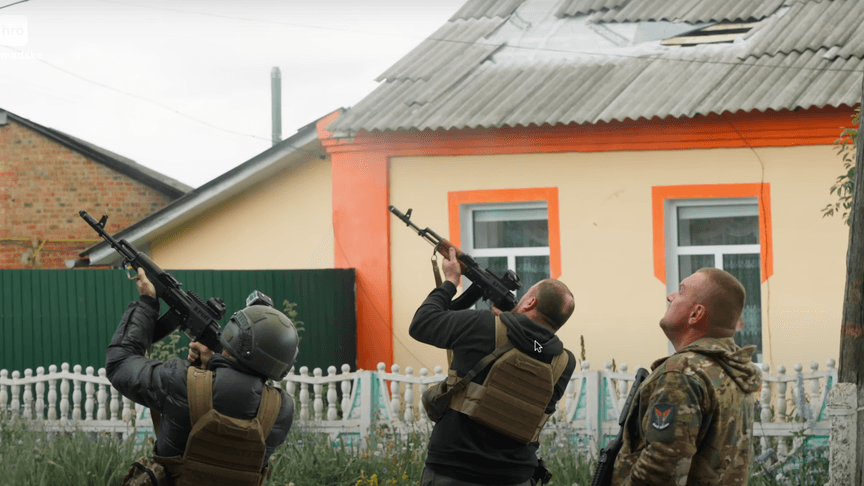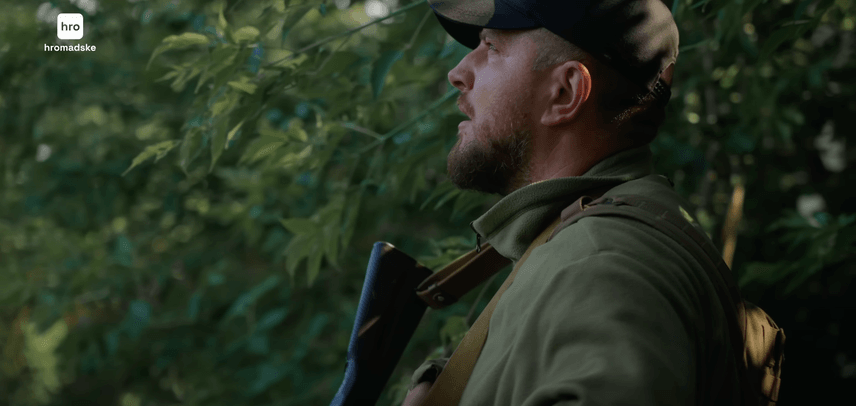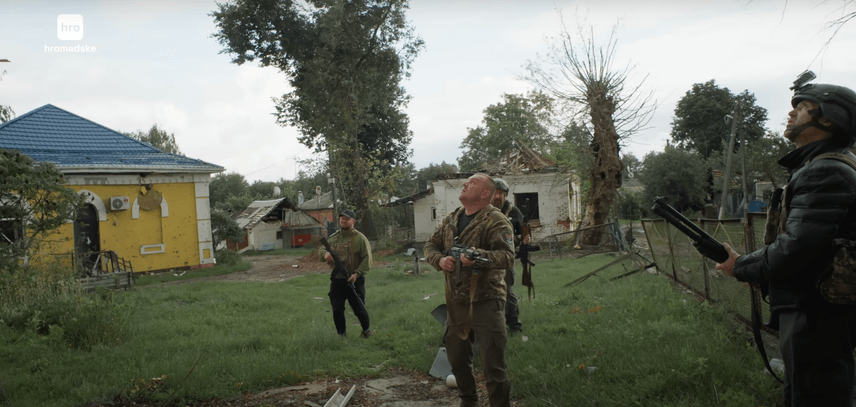Why Russians advanced in Sumy Oblast

A drone hovers over the sky of Khotin. Its incessant buzzing ensures you can’t forget it’s there for a moment. Four fighters from the Territorial Community Voluntary Formation raise their rifles to the sky, trying to shoot it down—no luck. The drone keeps hovering.
“It’s like this every day here. Up in Khotin, there are even more. A ton of them,” says Dmytro Suslovets, head of Khotin’s TCVF, when asked if the village is constantly swarmed with drones.
The hospital where Suslovets and other fighters stand, rifles pointed skyward, is in the village’s lowlands. From here, you can see the damaged church dome and the ruined lyceum.
“The situation is critical,” he comments tersely.
To document the situation in Khotin, a village on Sumy Oblast’s border, hromadske journalists must move quickly from one shelter to another.
This came as a shock. Just back in February, as we saw, Khotin was a village bursting with life. Despite being 6 miles from the Russian border, Khotin had a functioning store, library, and hospital, and buildings were swiftly repaired after strikes. The Khotin community was, without exaggeration, the most well-kept on Sumy’s border.
In June, the front arrived in Khotin. Though the line of contact is still 3 miles away, guided aerial bombs (KABs) and drones bring war from the sky daily, disfiguring a village that, just months ago, was picturesque.
“It hurts everyone. The village was just starting to get back on its feet, to rebuild. The road, hospital, leisure center, lyceum, and new school—everything’s destroyed, nothing left. I don’t know if we’ll live to see it rebuilt,” Suslovets says, looking at the wrecked hospital.
Outside, shards of broken windows and facade litter the ground; inside, ceilings crumble from strikes. Only the medicines left on a cabinet shelf hint that this was once a hospital.
We can’t reach the village center, located on higher ground (Khotin is a tactical elevation): the drone still trails our group.
“We’re hoping for the best. Hoping that, thanks to our Armed Forces, we can at least hold them where they are now, or better yet, push them back to the state border,” Suslovets says when asked about Khotin’s future.

“I’ve never seen fortifications this bad anywhere else”
Since Ukrainian forces withdrew from Kursk Oblast, the Russians have advanced 12 miles toward Sumy, occupying about a dozen villages in the Khotin and Yunakivka communities. It’s 9 miles in a straight line from Khotin to Sumy. Khotin and Yunakivka are tactical heights, so the Russians are moving toward them. From this distance, they could hit the regional capital with artillery.
Soldiers from various units defending the Pivnichnoslobozhanskyi sector tell hromadske that the main reason for the enemy’s success is the lack of proper fortifications in Sumy Oblast. Because of this, retreating Ukrainian forces couldn’t dig in.
“I’ve never seen fortifications as bad as those in Sumy Oblast anywhere else,” says an experienced paratrooper.
Observation posts in open fields, overly wide embrasures that drones can fly through, trenches without drone cover—these are some of the flaws soldiers cite. While working in Sumy Oblast, hromadske saw this firsthand. Journalists observed earlier-built observation posts in open fields but also new ones being constructed in wooded areas.
Some soldiers say they did occupy pre-dug trenches but had to extensively reinforce them.
The current head of the regional military administration, Oleh Hryhorov, told hromadske that the administration only assists in building defensive lines, with decisions on where and how made by military leadership.
“This is a military matter, and they determine how many fortifications are needed for defense. For our part, we’ll involve as many people as possible and keep improving the pace if needed,” Hryhorov said.

After the Russians broke through into Sumy Oblast, the commander-in-chief created a separate tactical group to prepare Sumy for defense. Another hromadske source in the administration noted that initial interactions with this tactical group’s leadership seemed productive and constructive.
hromadske sent a request to the State Bureau of Investigation asking whether it’s investigating prior abuses in Sumy Oblast’s fortification construction. The bureau declined to respond, citing the confidentiality of pretrial investigations.
“The advance on Sumy has, in effect, been stopped”
Another reason for the Russians’ rapid advances, soldiers tell hromadske, is the deployment of newly formed brigades to the area.
After the Defense Forces withdrew from Kursk Oblast, some experienced brigades were redeployed or slated for redeployment to Donetsk Oblast, and some units were pulled back for reinforcement. Meanwhile, the newly formed 156th and 158th brigades, among others, were brought in, struggling to hold their assigned front.
More experienced soldiers defending alongside these brigades complain about their organizational issues, lack of equipment (like drones), and poor situational awareness on the battlefield. In one of these brigades, according to hromadske sources, a battalion commander went AWOL.
On June 26, Commander-in-Chief Oleksandr Syrskyi said the situation in Sumy Oblast had been stabilized. The 95th Air Assault Brigade entered partially occupied Yunakivka and, according to soldiers, stabilized the chaotic front section and began retaking the village. Additionally, the 225th Assault Regiment liberated Andriyivka—a small village in the Khotin community—halting the advance toward Khotin and the Sumy-Sudzha road from that direction.
“At this point, I think we have enough forces to stop it all. In effect, we’ve already stopped it. As for pushing them back [to the border], I think we can do it gradually. I’m talking at least about our sector and our 225th Regiment,” says Oleksandr Klymenko, commander of the “Black Swan” strike group of the 225th Separate Assault Regiment, when asked how the Russian advance on Sumy will unfold.
Thanks to pushing the Russians back from some villages, their barrel artillery can’t yet reach Sumy. This is felt in the city itself, where hromadske spent two weeks—after a wave of panic, residents have returned to normal life. The same can’t be said for border villages like Khotin, constantly under attack. The Russians spare no guided aerial bombs, devastating Sumy Oblast’s borderlands, including Khotin.
- Share:
